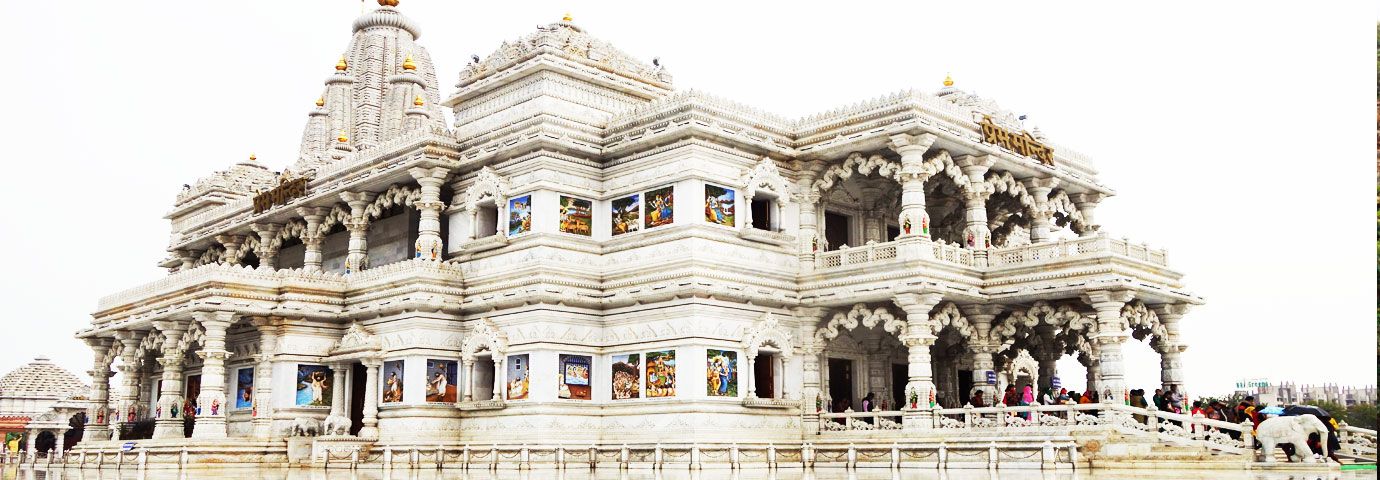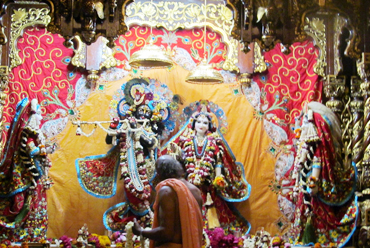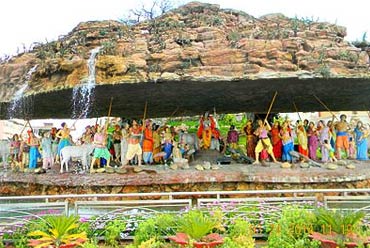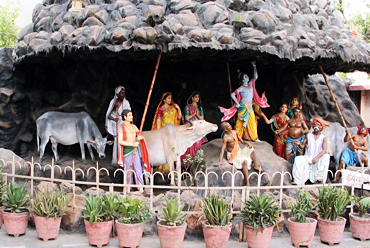Vrindavan is situated in the north Indian state of Uttar Pradesh around 151 km south of Delhi. It extends latitude 27°33¢ in the North to longitude 77°44¢ in the East. The place is just 10 km off Mathura, the place where Lord Krishna is said to have spent his childhood. Vrindavan is situated on the New Delhi-Chennai and New Delhi-Mumbai main railway line. A meter-gauge line connects Vrindavan to Mathura. There are quite a good number of passenger trains plying between these two places.
Best Time To Visit
Being a part of the Gangetic plain, Vrindavan faces extreme climate with hot and humid summer and chilly winter. The maximum temperature during the summer can reach a high of around 45°C and a low of around 5°C during the winters. Monsoon reaches this region in the first week of July and continues till the second week of September. The ideal season to visit Vrindavan is during winters (October to mid-March).
History
The name 'Vrindavan' is said to have been derived from 'Vrinda', another name for the sacred tulsi (basil) plant. A legend has it that the entire place was a tulsi grove at one time. According to another tradition, it was named after Vrinda Devi, one of Krishna's playmates. Whatever may be the case, Vrindavan is primarily a place of temples. Nearly 4,000 in number, which include several private shrines and sattras (houses for the distribution of alms), they are spread on a 10 km stretch. The earliest known shrine in Vrindavan is said to have been built by the local gosains in a large garden called Nidhiban, later named Seva Kunj. According to tradition, Emperor Akbar was taken blindfolded inside the grove where he had some kind of a spiritual experience. As a result, he acknowledged the spot as being holy ground. The four temples that were built in honour of his visit are Govind Deva, Madan Mohan, Gopinath, and Jugal Kishore. The first is an impressive edifice built in red sandstone. Architecturally this temple is one of the finest in North India. The beautiful tower that exists has lost some of its upper stories. A mutilated inscription on one of its walls records that Raja Man Singh of Amber built the temple in 1590. At the time of Aurangzeb, the principal image was removed from Vrindavan to Jaipur.
However, apart from its history, what keeps Vrindavan alive in the popular imagination of the people is its rich legend and mythology. Vrindavan is considered the place where Lord Krishna spent his early childhood. It was here that Krishna indulged in adolescent pranks with the gopis (milkmaids) in the forests and stealing their clothes while they bathed in the river. Little now remain of the legendary forests and the river has meandered away from most of Vrindavan's bathing ghats, but the Krishna effect is still there in the large number of pilgrims visiting this town.
Tourists Attractions
The Pagal Baba Temple has eleven stories in all and is one of the more modern pieces of architecture. The temple's creator, Pagal Baba, died only a few years ago. His infectious spirit lingers on in the playfulness of his disciples who are ready to welcome one into the temple interior. It is possible to ascend to the ninth story if the monsoon heat and one's constitution allows.
One of the most important and vibrant temples is the Bankey Bihari Temple, where one can expect to see devotees engaged in simple acts of worship such as ecstatically clashing small cymbals together as they move in time to ancient rhythms. The Bankey Bihari Temple houses a sacred image of Krishna known as Thakkur Ji, which shows Krishna with an almost blackened body. Devotees enter the shrine room carrying garlands of flower petals and offer them to the spirit of the statue as Brahmins move back and forth in front of the icon, occasionally drawing across the curtain to shroud the object of devotion for a moment.
The Govind Dev Temple was built in 1590 by Raja Man Singh and now lies empty, its upper layers having been torn down during the time of the Mughal emperor, Aurangzeb, who doubtless considered the place one of idolatry. What remains of this red sandstone edifice is impressive. If one takes the time to examine the artwork and in particular, the vaulted ceiling, one may experience a lot of the devotional fire that inspired it in the first place. The Rangaji Temple dates from 1851 and is a mixture of architectural styles, including a Rajput entrance gate, a soaring south Indian gopuram (gateway tower), and an Italianate colonnade.One of the most impressive temples is the ISKCON Temple, which was built with funds from devotees overseas. Here, the marble buildings almost glow with a light of their own and there is evidence of intricate carving.
Places Around Vrindavan
Mathura is the place where according to Hindu mythology, Lord Krishna born. The place is closely linked with many episodes in the early life of Krishna. The main places to visit are Shri Krishna Janmabhoomi, Vishram Ghat, Sati Burj, Kans Qila, Jama Masjid, Dwarkadheesh Temple, and the Archeological Museum. Gokul and Mahaban nearby are the places where Krishna was secretly raised. Thousands of pilgrims visit these places during the birthday festival of Lord Krishna (Janmashtami) in July/August.
Barsana is the place where Krishna's consort Radha was born. The place is especially interesting during the festival of Holi when the women of Barsana attack the men of nearby village Nandgaon with sticks and play the Lathmar Holi.An eighteenth-century stronghold of the Jat rajas with its picturesquely contrived garden-cum-water palaces, Deeg is a popular tourist rendezvous today. It is situated around 21 km off Vrindavan. Agra, the capital of great Mughals and city of Taj Mahal is around 67 km off Vrindavan.
Fairs And Festivals
Celebrations are, in fact, a way of life in Vrindavan. Any occasion is a time to celebrate and remember the name of God. Chanting of the names of Radha and Krishna, dancing, singing, etc., are the ways that are considered to take a devotee from this physical world to the heavenly abode. Janmashtami in the months of July/August is celebrated as the birthday of Lord Krishna and thousands of devotees throng the place from all over the country. Holi is also celebrated with as much enthusiasm.Almost everyday there is a festival in Vrindavan, but the major ones include Govardhan Puja, Guru Poornima, Holi, Govardhan Puja, Jhulan Yatra (swing festival), Radhashtami, and Basant Panchami.
How To Reach
By Air - The nearest airport is Agra around 67 km away from Vrindavan. There are regular flights to other important tourist destinations of India such as Delhi, Mumbai, Varanasi, and Khajuraho. The nearest international airport is Delhi, which is connected to almost every important city in the world with major airlines.
By Rail - Though Vrindavan itself is a railway station, the major railway station nearby is Mathura on the Delhi-Chennai and Delhi-Mumbai main line. Several express trains connect Mathura from other major cities of India like Delhi, Mumbai, Chennai, Bangalore, Kolkata, and Agra.
By Road - Vrindavan is connected to Mathura and all other places of interest in Braj. We would provide you all India tourist permit vehicles for the local transportations and also for the intercity drives too.
Tourism-of-India.com provides complete information about tourism in Vrindavan. Tourism-of-India.com offers various tour packages to make your visit comfortable. You can pick the one that suits you most.





